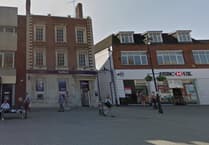Has Surrey become Britain’s sinkhole capital? Well, the figures certainly point in that direction.
Surrey County Council is on track to spend a staggering £1.6 million fixing the collapsed 65ft hole in a section of Godstone High Street – a bill that dwarfs what most local authorities spend on sinkholes.
Figures obtained through Freedom of Information (FOI) requests show councils across the UK have spent more than £6.2 million tackling over 7,000 sinkholes since 2020. But Surrey alone accounts for almost half of that total, shelling out over £3.1 million making it by far the country’s biggest spender.
The Godstone collapse, which first appeared in February, has left the part of the High Street shut for months and businesses struggling.
Surrey County Council has already spent £850,000 on emergency responses, surveys, roadworks and consultancy fees, including £360,000 on just site establishment.
Another £800,000 is forecast for stabilisation work, filling in the mine tunnels, and further repairs – taking the final bill to £1.65 million. This will amount to just over a quarter of the total UK bill on sinkholes for the last five years.
What is driving the cost?
The British Geological Society has stated that Surrey is particularly prone to sinkholes due to the underlying sands in the county, which are weakly cemented.
According to council documents, the ground beneath Godstone sits on the Folkestone Sandstone Formation – a weak, sandy foundation that made the area vulnerable to collapse. CCTV images provided under FOI request confirm the collapse was worsened by an old sand mine tunnel running beneath the High Street.
While the council insists the road should reopen by December 16, locals are not holding their breath. Residents have been struggling for months with the road closure, diversions, fall in trade and general feel of chaos. That being said, an official report by the council does state that the project is tracking towards a final inspection date of December 16.
A Surrey County Council spokesperson said: “This continues to be a highly complex incident involving a number of investigations led by our Highways Officers and other agencies, including specialist teams and utility companies.
“Work is underway to reconstruct the final footpath affected by the collapse and we’re now planning how we stabilise the collapsed area and fill in the tunnel network.
“We are updating local residents and businesses as we progress through each stage of the process and expect the final two residents to be back in their properties by the end of September.
“Once our stabilisation work and the SES works to reconnect and relay the mains through the collapse area are completed, the area will be refilled and repaired permanently. We are currently planning to complete our repairs and reopen the High Street during December.”
A nationwide problem
The Godstone collapse may be dramatic, but it’s part of a wider and growing problem. Since 2020, sinkholes have been recorded everywhere from Reading to Scotland, with councils spending millions to patch them up.
The top spenders after Surrey include Reading (£976,500), East Sussex (£767,238) and Transport Scotland (£602,000). If you take away the Godstone sinkhole expenditure, Surrey still comes up top with over £2.2m being put towards sinkholes.
Additional reporting by Sam McEvans.





Comments
This article has no comments yet. Be the first to leave a comment.